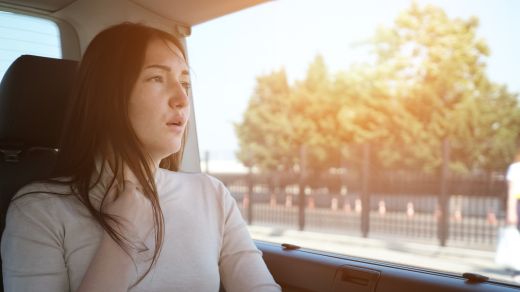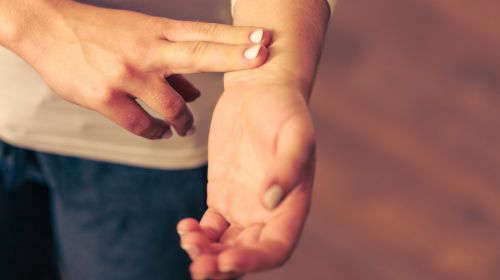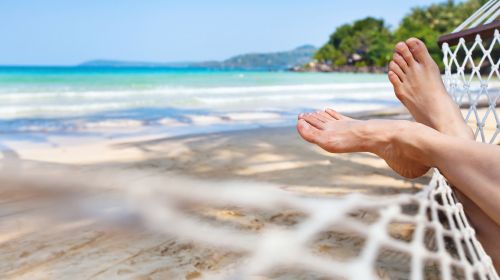Some people are suddenly overwhelmed, while others are already afraid to start their journey: with motion sickness, symptoms such as nausea and vomiting can spoil the trip on vacation or the sailing tour. What helps against the symptoms.
- © Getty Images/LENblR
Brief overview: motion sickness (kinetosis)
Definition: Motion sickness, seasickness, flight sickness or motion sickness – behind these synonyms there are a number of symptoms that occur when travelling.
Causes: Movement stimuli to the brain do not match the visual signals; as a result, the vomiting center is activated.
Happen: Many people get motion sickness on winding car journeys, on a ship in rough seas or on long-haul flights.
Symptoms: Possible symptoms are malaise, dizziness, nausea and vomiting, headaches, sweating and paleness.
Therapy: Taking anti-nausea medications, available as patches, chewing gum, tablets, or suppositories, as well as essential oils such as peppermint, ginger lozenges, or cool drinks can help.
Article content at a glance:
What is motion sickness?
Travel sickness (kinetosis) occurs when the movements that the organ of balance in the inner ear and other sensors (e.g. on the soles of the feet and joints) register do not match the visual signals received by the eyes. The brain thus receives conflicting information and interprets it as a danger. Stress hormones and histamines are released, physical defense mechanisms are set in motion and the vomiting center in the brain is activated.
Which medicines help against motion sickness?
There are various medications to treat motion sickness. The active ingredients contained in it suppress the vomiting center (antiemetics such as scopolamine) and dampen the release of messenger substances (antihistamines such as dimenhydrinate). As a result, nausea and vomiting can subside. The active ingredients are available as
- Pavement,
- Chewing gum,
- tablets
- or suppositories.
They develop their effect with a time delay, so that the medication is taken several hours before departure, sometimes the day before.
When taking medication for motion sickness, those affected should note that some active ingredients have side effects: For example, they can reduce the ability to react and make you sleepy. Also, not all motion sickness medications are suitable for children. Therefore, you should discuss with your family doctor or pharmacist before the trip what can be taken under what conditions and by whom.
What else can you do about motion sickness?
Motion sickness is uncomfortable but usually harmless. If you don’t want to take medication, you can try other measures – whether in the car, on the ship or on the plane.
Essential oils, lozenges and cool drinks help against nausea and vomiting. Well-known remedies for nausea are, for example, ginger, lemon or peppermint. Tea made from fennel, aniseed and/or caraway calms the stomach.
That helps in the car
If travel sickness occurs in the car, one should first Take a break away from the route and ventilate the interior of the car, because stuffy air promotes nausea and vomiting. Exercise in the fresh air can sometimes be enough to relieve travel sickness. You can drink cool water with lemon or put a damp, cool cloth on your neck or forehead. Chewing gum also helps against motion sickness.
Distract on the plane
At the first sign of motion sickness, try not to move your head, but press it firmly into the headrest. Breathe calmly and evenly and look ahead instead of out the side window.
On the plane, the symptoms often occur in connection with a fear of flying. Anyone who suffers from dizziness during turbulence should not read, distract themselves (listen to music, watch a film), breathe calmly and drink small sips regularly.
Sleep a lot on the ship
Instead of sitting in the cramped, stuffy cabin, staying on deck, preferably in the middle of the ship, is advisable. You can fixate on the horizon and breathe in a lot of fresh air.
You can overcome seasickness even with a lot of sleep, because your sense of balance is inactive when you sleep. Seasick people should avoid alcohol, hard-to-digest food, coffee and nicotine during the journey.
Risk factors and triggers of travel sickness
Motion sickness can occur whenever the brain recognizes a conflict between the sensory perceptions and the signals from the vestibular system.
When driving, the risk is particularly high on roads with many bends or when you repeatedly brake and pull away in a traffic jam. Typically, the driver is not affected by travel sickness: signals are sent to the steering hands in advance, telling them where to go next, so that their inner ears and eyes can adjust accordingly.
When traveling by air, the turbulence that occurs is the main reason for disturbed sensory perceptions.
On the bus, winding routes, a seat in the back and, on a train journey, the tilting technology in the ICE increase the risk of nausea and vomiting.
In addition, when traveling, you tend to get sick if you don’t look in the direction of travel, but read or look at your smartphone or tablet.
Travel sickness without a trip
Motion sickness is not always associated with a trip: it sometimes affects sensitive people when watching a 3D film, playing computer games, using virtual reality (VR) glasses, in a flight simulator or on rides such as carousels and roller coasters.
Who is affected by motion sickness?
Motion sickness does not affect everyone. Very small children up to the age of two are rarely affected because their vestibular system is not yet fully developed. Older people also suffer less from nausea and vomiting when travelling. With them, experts assume that the aging process has reduced the ability of perception in the brain and the function of the vestibular system.
Travel sickness is particularly common among children between the ages of two and twelve. In some children, the vestibular system is apparently so sensitive that the centrifugal forces in curves in particular can lead to nausea.
Motion sickness symptoms
Symptoms can manifest themselves differently in different people:
- increasing malaise
- dizziness and lightheadedness
- fatigue
- nausea
- Vomit
- Headache
- paleness
- sweats
- chills
In severe cases, symptoms range from drowsiness and apathy to even depression and fear of death.
The duration of the symptoms usually depends on the length of the journey: The symptoms usually disappear quickly when the movement is over. On sea voyages, you usually get used to it after two to three days: the body has then adapted to the unfamiliar impressions, and the sensory organs, vestibular system and brain are working in the same rhythm again.
Prevention: The best tips against motion sickness
A few measures can be taken to ensure that travel sickness occurs less frequently or less severely during the trip:
Begin the journey as rested and stress-free as possible.
Avoid alcohol, nicotine and coffee during the trip.
Do not drink carbonated beverages while driving.
Plan sufficient breaks with lots of fresh air.
If you are prone to travel sickness, you should drive your own car if possible.
The seat is also important. In the car, the front passenger seat is the best place, in the bus in the front and on the plane and train an aisle seat is optimal – here you can get up more often and walk a few steps.
It is best to always look in the direction of travel when you are on the road.
If you tend to feel nauseous on an airplane, it is best to sit in the middle row at wing height.
If there is an opportunity, it is better to book an outside cabin with a window on the ship. Seasick people are better off staying in the middle of the ship or ferry and on deck in the fresh air for short crossings.
If you have a tendency to travel sickness, it is best to sit in the front of the bus.


